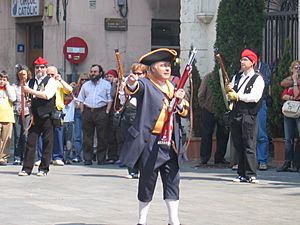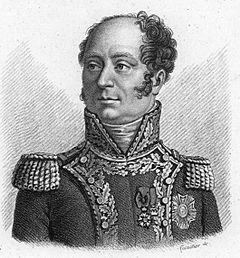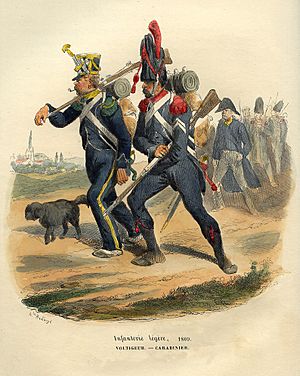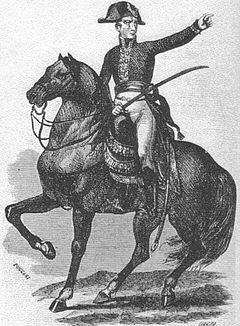Siege of Figueras (1811) facts for kids
Quick facts for kids Siege of Figueres |
|||||||
|---|---|---|---|---|---|---|---|
| Part of Peninsular War | |||||||
 Sant Ferran Fortress is located on a hill near Figueres. |
|||||||
|
|||||||
| Belligerents | |||||||
| Commanders and leaders | |||||||
| Units involved | |||||||
| Strength | |||||||
| Rovira's coup: 900 Relief: over 7,000 Siege: 15,000 |
Rovira's coup: 2,000 Relief: over 10,800 Siege: 7,000 |
||||||
| Casualties and losses | |||||||
| Rovira's coup: 900 Relief: 400 Siege: 2,000 |
Rovira's coup: 25 Relief: 1,000 Siege: 7,000 |
||||||
The Siege of Figueres was a long battle that happened during the Peninsular War in 1811. This war was part of the bigger Napoleonic Wars. The battle took place at Sant Ferran Castle (also called San Fernando Fortress) near Figueres, Spain.
The Spanish soldiers, led by General Juan Antonio Martínez, defended the fortress against a large French army. The French army was commanded by Jacques MacDonald and Louis Baraguey d'Hilliers. The Spanish held out for much longer than expected, from April 4 to August 19, 1811. In the end, they had to give up because they ran out of food.
Contents
What Was the Siege of Figueres?
The Siege of Figueres was a key event in the Peninsular War. This war was fought between France and its allies against Spain, Britain, and Portugal. The French army, led by Emperor Napoleon, wanted to control Spain.
The Sant Ferran Fortress was very important. It was located on a hill overlooking Figueres. This meant it controlled a major road from Barcelona, Spain, to Perpignan, France. The French had captured the fortress in 1808. They used it as a main supply base for their army.
In January 1811, a French general named Louis Gabriel Suchet captured the city of Tortosa. After this, another French general, Jacques MacDonald, moved his troops. But his soldiers faced a tough fight in the Battle of Pla.
Emperor Napoleon was not happy with MacDonald's performance. He told MacDonald to give 17,000 soldiers to General Suchet. Napoleon wanted Suchet to capture Tarragona, a very important port city. Suchet started moving his army towards Tarragona in April 1811.
How the Spanish Took the Fort
The French generals had become too relaxed about the Sant Ferran Fortress. In April 1811, only a small group of Italian soldiers, who were allied with France, were guarding it. The fort's governor, General François Gilles Guillot, was not very careful.
This gave a fighting priest named Francesc Rovira i Sala an idea. He led a group of Spanish fighters called miquelets. Rovira planned a surprise attack to take back the fort. He had help from three young Spaniards who worked inside the fort. They were Juan Marquez and the brothers Ginés and Pedro Pons. Marquez secretly made copies of the keys to a small back gate and the storage rooms.
On April 7, 1811, Rovira gathered 2,000 miquelets. They pretended to attack towards France to trick the French. But on April 9, they turned towards Figueres.
In the early morning of April 10, 700 miquelets quietly went to the back gate. Marquez and the Pons brothers were waiting. They unlocked the gate, and the miquelets slipped inside. They quickly overpowered the guards and captured General Guillot in his bed. Within an hour, the Spanish fighters controlled the fortress. They opened the main gates to let in the rest of their forces. By the next day, 2,000 miquelets were inside.
The Spanish captured about 900 Italian soldiers and many supplies. They took hundreds of cannons, 16,000 muskets (rifles), lots of clothes, and enough food for 2,000 men for four months. They also found a lot of money. The Spanish only lost about 25 men. Emperor Napoleon was very angry about losing such an important fort.
The French Try to Take it Back
After the Spanish took the fort, General Luigi Gaspare Peyri and his Italian soldiers retreated. General Louis Baraguey d'Hilliers quickly sent more troops to Peyri. Peyri returned to Figueres and set up defenses in the town. But his force was too small to stop Rovira from bringing more miquelets into the fort.
Rovira put General Juan Antonio Martínez in charge of the fortress. Within a week, 3,000 miquelets were defending it. D'Hilliers gathered more soldiers and started to surround Sant Ferran on April 17.
Meanwhile, Spanish General Joaquín Ibáñez Cuevas y de Valonga, Baron de Eroles marched his soldiers to Figueres. On the way, he captured French groups in other towns. Eroles brought his Spanish regular soldiers into Sant Ferran on April 16.
The Spanish commander, Luis Gonzalez Torres de Navarra, Marquess of Campoverde, was slow to react. He finally moved his army from Tarragona on April 20. His force had 6,000 foot soldiers and 800 cavalry. Rovira's miquelets outside the fort tried to join Campoverde's army.
On May 3, 1811, General Pedro Sarsfield's Spanish division attacked the French lines near Figueres. Rovira's fighters helped by creating a distraction on the other side. Eroles' troops came out of the fortress and joined Sarsfield. They attacked the town of Figueres.
The French fought hard. While they were talking about surrendering, the Spanish tried to get more supplies and gunners into the fort. But d'Hilliers gathered his main troops and surprised Sarsfield from behind. The Spanish were forced to retreat. Eroles' soldiers went back inside Sant Ferran. Campoverde did not use his reserve troops to help.
The French lost 400 soldiers in this fight. The Spanish lost over 1,000 men. Soon after, Campoverde heard that General Suchet's French army was closing in on Tarragona. Since Tarragona was very important, Campoverde quickly left Figueres. He sent some troops to bother Suchet's supply lines. He took 4,000 soldiers, put them on ships, and sailed to Tarragona.
The Final Days of the Siege
Before the French could fully surround the fort again, Eroles left with some soldiers. This left General Martínez to defend Sant Ferran with about 3,000 miquelets and 1,500 Spanish regular soldiers. By the end of May, over 15,000 French troops were outside Figueres. General MacDonald took command. He built strong defenses to keep the Spanish inside and any help out.
On June 28, 1811, the Siege of Tarragona ended. The French captured the city, and the Spanish suffered huge losses. This meant no help would come for Figueres.
General Martínez continued to defend Sant Ferran bravely through May, June, and July. He put his soldiers on half-rations to make their food last longer. Rovira had gone to Cadiz to ask for help, but none could be sent. MacDonald did not try to break the fort's walls with cannons. Instead, he waited for the Spanish to run out of food. Meanwhile, many of his own soldiers got sick from diseases like malaria and dysentery.
By mid-August, the Spanish defenders had eaten almost everything, even horses, dogs, and rats. They only had three days of food left. General Martínez planned a breakout attempt for the night of August 16. Rovira and 2,000 fighters tried to create a distraction outside.
Martínez led his strongest troops in a massed attack on the French lines. They got past the first French guards. But they were stopped by a thick barrier of sharpened stakes and branches. While they were stuck, two French cannon batteries fired on them. After losing 400 men, the remaining Spanish soldiers ran back into the fortress.
The next day, Martínez agreed to surrender. On August 19, 1811, the Spanish soldiers marched out and gave up their weapons. During the siege, 4,000 French soldiers died, mostly from sickness. Of the Spanish defenders, 1,500 died, 1,000 were sick, and 2,000 were taken prisoner. Juan Marquez, who helped the Spanish take the fort, was found among the prisoners and sadly hanged.
What Happened After?
Even though the Spanish lost the fort, Rovira and Martínez did a great job. They kept a large French army busy for the whole summer. This meant the French could not send these troops to help capture Tarragona.
In July 1811, a new Spanish commander, Luis Roberto de Lacy, took over in Catalonia. He started a strong campaign with the remaining Spanish troops. In August, he even attacked French territory.
In September, Lacy reorganized the Spanish army. With help from the British navy, he captured some islands. In October, he destroyed several small French groups in the Battle of Cervera. This forced the French to leave another important area. General MacDonald was called back to France in October. His reputation had been damaged by his performance in Spain.







